RENEGADE GARDENER™
The lone voice of horticultural reason
The 2005 Renegade Gardener High Spot / Black Spot Awards
12-9-05 – GOOD EVENING ladies and gentlemen, fellow Renegade Gardeners, and all fair comrades from across the globe. I come to you today live from the Kabetogama Ballroom inside the Lost Portage Lodge, Bingo Center and Pull Tab Emporium in beautiful downtown Tofte, Minnesota, located just a short drunken fall from the savagely frozen shoreline of Lake Superior, and the site of this year’s Renegade Gardener High Spot/Black Spot Awards.
Votes have been tallied, envelopes sealed, and bribes long ago laundered through my tawdry landscaping business, so drop the lights, cue the orchestra, and let the award ceremony begin!
 Black Spot Award
Black Spot Award
Most Egregious Use of Plastic in an Outdoor Environment: Boulder Bus Stop
Plastic rocks just keep getting bigger and more dangerous, to the point where they now are capable of completely engulfing small children. While a noble cause—giving kids a safe and dry place to smoke while waiting for the school bus—this function has been served in this country for probably one hundred and fifty years through the use of sawn, fitted, and fastened cedar lumber, and the 2005 award judges found no reason why the establishment of an attractive wooden structure on one’s property for the safekeeping of youths in transit is in any way improved upon via the procurement of a product that looks like a portable privy after a date with a major forest fire.
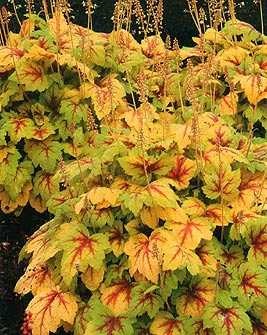 High Spot Award
High Spot Award
Perennial of the Year: Heucherella ‘Stoplight’
Half the battle in the creation of a splendid garden and overall stellar landscape is learning the “A” list of plants. In the north, even the shortest A list of perennials must include the heucherellas, a newer genus of plant spun off from the equally essential heuchera family.
Oregon’s Terra Nova Nurseries, one of the planet’s truly great creators and purveyors of new perennial varieties, came up with ‘Stoplight’ several seasons back, and for riveting, stop-in-your-tracks impact I don’t think there’s a more visually commanding perennial.
Growing slightly larger than its parent, H. ‘Sunspot,’ ‘Stoplight’ features bright yellow to yellowish green leaves with blood-red central veining; sturdy, slender stems host baubles of white flowers in early summer. Grow it in part shade (avoid intense early afternoon sun) in neutral to slightly acidic, well-drained soil. Hardy to USDA Zone 4.
Black Spot Award
Least Important Press Release: All-American Daylilies™ 2005 Winners
Just what the gardening world needs, of course, more daylily varieties, and 2005 didn’t disappoint. All-American Daylilies™ is a marketing ploy, part of the fiendish branding craze that has swept through the American gardening industry over the past several years (see award below).
How important was this press release? There are two winners for 2005, ‘Red Volunteer’ and ‘Miss Mary Mary.’
Why no pictures included with this snippet? Please bear in mind, every time my web master places a picture with an article on this site, it costs me a few bucks. So help me out … ‘Red Volunteer’ is red, with a yellow throat (CLOSE EYES, VISUALIZE A RED DAYLILY WITH YELLOW THROAT). ‘Miss Mary Mary’ is that most desperately needed of all new daylilies, a yellow (CLOSE EYES, VISUALIZE A YELLOW DAYLILY).
See? When the discussion is about daylilies, who needs pictures? Besides, all pictures of daylilies in catalogues will only feature the bloom in close-up, often bleeding out of the frame. That’s because daylily foliage is so numbing and unattractive, especially by late summer, when it’s browning up and flailing about the garden bed, as pleasant to view as road kill twitching for its final breath. And by the way, these two essential new daylilies are somehow infinitely more vital to your garden than the previous forty thousand (that’s correct, a four followed by four zeroes) registered daylily varieties.
If you’re new to the site, enjoy daylilies, and want to get really mad at me, please read Enough with the Damn Daylilies.
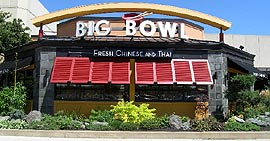 |
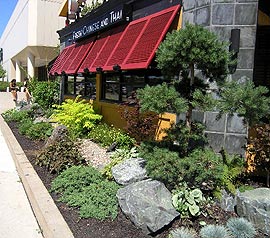 |
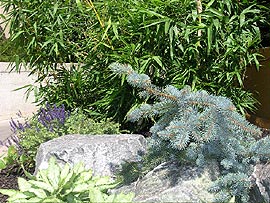 |
High Spot Award
Best Retail Landscaping: Big Bowl, Ridgedale Center, Minnetonka, Minnesota
Over the years, via e-mail, more than a few of you fine comrades have cautiously asked, “Don, with the state of retail commercial landscaping in America being what it is today, how do find enough strength to get out of bed most mornings?”
A fair question, deserving of an honest answer. Sometimes the only thing that keeps me going is stumbling upon retail outfits such as the Big Bowl chain, a company that despite all quickening trends toward sickening, nugatory landscaping, has the brains and the gusto to give us this.
It’s just so easy. Hire a decent damn landscaper, pay a few more bucks, show the public you run a creative, first-class operation. Does this landscaping drive traffic inside the restaurant? Of course it does.
Excellent food at Big Bowl, by the way, and very reasonably priced. The chain is based out of Chicago, and that might have something to do with why the landscaping around most of their outlets is first rate; when it comes to commercial and civic landscaping, The Big Windy is a city that gets it.
High Spot Award
Shrub of the Year: Physocarpus opulifolius ‘Center Glow’
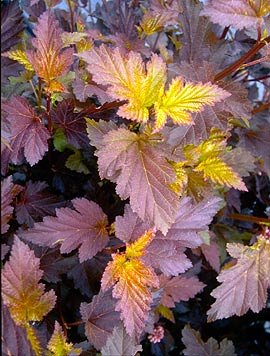 I’m guilty of jumping the gun here; truth of the matter, this new, fabulous ninebark will not be for sale to the public until next spring, in limited quantities, with full market release scheduled for 2007.
I’m guilty of jumping the gun here; truth of the matter, this new, fabulous ninebark will not be for sale to the public until next spring, in limited quantities, with full market release scheduled for 2007.
But I can’t resist alerting readers to what I believe will be a future all-star shrub, and don’t see any reason to wait until next year’s awards to honor it. ‘Center Glow’ is a hybrid between Physocarpus opulifoius ‘Diabolo’ and P. opulifolius ‘Dart’s Gold’ that has been developed by the Landscape Plant Development Center at the University of Minnesota Landscape Arboretum in Chaska, Minnesota.
I planted one in my landscape this spring, and I adore it. Spring and early summer foliage is rosy red with a golden base. Leaves lose the yellow “center” as they mature through summer, moving toward burgundy—the shrub gives you a different look month-to-month. Plants can become quite large (8-10’ in height and width) but like all the ninebarks, smart pruning will keep them more compact.
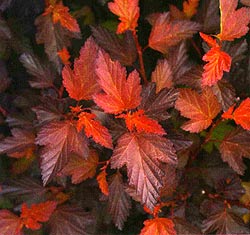 |
| Physocarpus opulifolius ‘Coppertina’ |
Profuse, golf ball-size clusters of whitish pink flowers are produced in mid-summer. Grow all ninebarks in full sun for best foliage color and bloom. Neutral to slightly acidic, well-drained soil is preferred, and remember, ninebarks don’t like to get too dry—foliage will wilt, telling you you’re about a day late with the water. Hardy to Zone 4.
Spring 2006 also be on the lookout for two additional new ninebarks, ‘Coppertina’ and ‘Summer Wine.’ Both are hardy to Zone 3. I’ve been yelling on this site about how great ninebarks are for five years, so it’s great to see demand from gardeners and the landscaping trade stir some lively action.
Black Spot Award
Worst Perennial of All Time: Echinacea pupurea ‘Doppelganger’
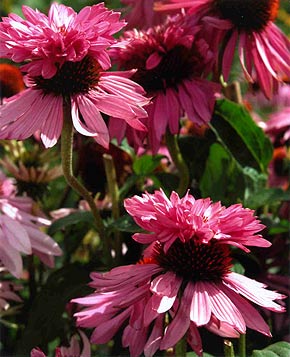 What, me flog a dead horse? Of course. Even though I mentioned this hideous monster of a plant in an earlier update this year, something as ghastly as ‘Doppelganger’ deserves a second castigation—not to mention the coveted Renegade Gardener Black Spot Award for Worst Perennial of All Time.
What, me flog a dead horse? Of course. Even though I mentioned this hideous monster of a plant in an earlier update this year, something as ghastly as ‘Doppelganger’ deserves a second castigation—not to mention the coveted Renegade Gardener Black Spot Award for Worst Perennial of All Time.
I’ve learned more about the plant’s origin. It was found as a freak plant (as I should have guessed) in a private garden in Germany. Some sorry, mutant gene in one lousy coneflower had zigged when it should have zagged and prompted a second, off-kilter set of stunted pedals to erupt, acne-like, from the center seed head.
One lousy plant. Rather than do the merciful thing—destroy it, from a safe distance, with a flamethrower—the astute german gardener propagated it, by division, and eventually sold his stock to Jackson & Perkins. They gave it the fancy German name for double-decker, propagated the count up to a few hundred thousand, and gleefully brought it to market.
What’s the problem? Well, aside from being really, really ugly—ugly in a gives-you-shivers, kitten-with-two-heads sort of way—it’s the gall with which a commercial nursery (and thousands of eager retail counterparts) trumpeted the plant as the next big thing.
When I shot down the plant on this site this summer, I received a total of twelve e-mails on the topic, each in agreement that the plant was ludicrous. Three were from retail nursery owners who had refused to stock it.
High Spot Award
Best Gardening Book: Landscaping with Native Plants for Minnesota
By Lynn Steiner (Voyageur Press) $24.95
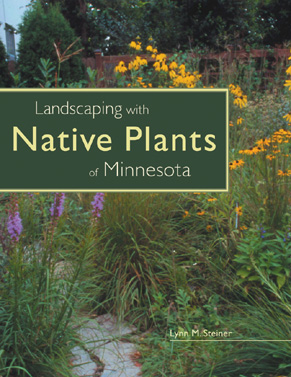 Nearly one hundred new gardening books are published in America each year, a majority of which, I’m afraid, are adequately redundant at best, and altogether unnecessary at worst. Does anyone need another book on garden feng shui, composting, or flower color combinations?
Nearly one hundred new gardening books are published in America each year, a majority of which, I’m afraid, are adequately redundant at best, and altogether unnecessary at worst. Does anyone need another book on garden feng shui, composting, or flower color combinations?
The small number of new books with merit tend to be regional, focusing on plants or procedures made vague by glossy, hardbound, national releases. In this camp you will find the recently released Landscaping with Native Plants of Minnesota (Voyageur Press) by the wonderful Stillwater-based garden writer and photographer Lynn Steiner.
This book is the first to combine a field guide format with practical instruction about creative use of the plants and overall landscape design. “Beginning gardeners can use the book to learn about a whole world of wonderful plants the gardening magazines don’t often tell you about,” says Steiner, “while more advanced gardeners can look at using natives as a kind of next step, a further fine-tuning of the craft.” With this beautifully written and photographed book, Steiner, the long-time former editor of the Minnesota State Horticultural Society’s Northern Gardener magazine, transforms readers of every stripe into native plant experts.
High Spot Award
RG Garden Product of the Year: Vine-X Vine & Brush Control
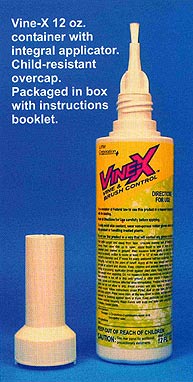 Ran into this product at a trade show two years ago, when it was first entering the market, talked to the engineers, and thought, well, if it works half as well as their testing shows, this is going to be pretty important stuff. They hadn’t tested it on buckthorn, the great, invasive scourge of Minnesota and an increasing number of states, but didn’t see any reason why it wouldn’t be completely effective.
Ran into this product at a trade show two years ago, when it was first entering the market, talked to the engineers, and thought, well, if it works half as well as their testing shows, this is going to be pretty important stuff. They hadn’t tested it on buckthorn, the great, invasive scourge of Minnesota and an increasing number of states, but didn’t see any reason why it wouldn’t be completely effective.
Now the results are in: Not only will Vine-X safely and efficiently knock out poison ivy, poison oak, sumac, kudzu, ailanthus, bamboo, Virginia creeper, blackberry, and more than 80 additional brush and vine species without spraying, it is completely effective at killing buckthorn.
I know because I’ve tested it on buckthorn in Deephaven, Minnesota, and it nails it dead every time.
Here’s what’s smart about Vine-X:
- The cap comes off the bottle to reveal a wick—there’s no spraying. Gently squeezing the bottle, you just “paint” the product onto the unwanted plant. You can treat and kill vines on a tree without affecting the health of the tree.
- The active ingredient is triclopyr butoxyethyl ester (triclopyr BEE) in a vegetable oil solution. Most other sprays and concentrates with triclopyr BEE are water-based. The vegetable oil allows Vine-X to penetrate the waterproof outer layers of weed trees and shrubs quicker, and without scoring or cutting.
- Vine-X does not penetrate the soil. Triclopyr BEE locks into the tissue of the plant and does not travel into the soil, nor does it wash off in rain. And because it is painted on and not sprayed, there is no damage to surrounding plants due to wind carry, and no chemical lands on the ground.
- Unlike spray weed-killers, Vine-X can be effectively used late March through October in northern gardens.
For those of us in areas infested with buckthorn, Vine-X is the answer. Cut your buckthorn down but leave eight to twelve inches of trunk, paint the trunk with Vine-X, and within two months it’s completely dead. Many woody plants and vines show the effects of treatment within days or one week.
Black Spot Award
Worst New Gardening Product: The Garden Shed Collection
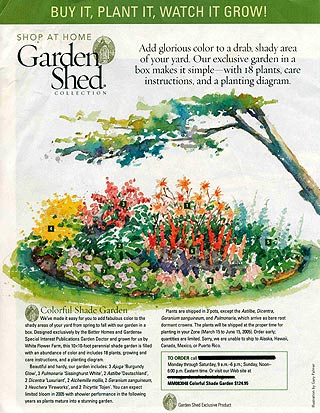 Oh, where to begin … with the mind-numbing headline across the top, I suppose: “BUY IT, PLANT IT, WATCH IT GROW!” Do you see the subliminal message it purveys to new gardeners, the labyrinth of assumptions it imposes? Wow, just think, all I need to do is pay $124.95, plunk the plants in according to the diagram, stand back, and watch ‘em grow …
Oh, where to begin … with the mind-numbing headline across the top, I suppose: “BUY IT, PLANT IT, WATCH IT GROW!” Do you see the subliminal message it purveys to new gardeners, the labyrinth of assumptions it imposes? Wow, just think, all I need to do is pay $124.95, plunk the plants in according to the diagram, stand back, and watch ‘em grow …
No worries about soil type, watering, fertilizing, deadheading, disease, pestilence or pain … gee, I think even a dumb beginning gardener like me can handle that! I love the opening paragraph: “Add glorious color to a drab, shady area of your yard. Our exclusive garden in a box makes it simple …”
Comrades, two things in gardening I want you to flee from always, as quickly as if from molten lava: anything called a “garden in a box” and any gardening task a marketing department describes as “simple.”
I’m sure it’s a fine looking garden after about five years, if you prepare your soil well, and know how to grow stuff. Some designer no doubt did a decent job selecting and arranging the plants. The kit includes three ajuga, three pulmonaria, a couple of astilbe, two alchemilla, and two each of four additional perennials, for a total of 18 plants. And the bloom times are such that you’ll have some stuff poppin’ pretty much all season long, although between you and me, fall looks a little iffy.
But what have you learned, Dorothy? Nothing. Realize that this is the gardening industry telling you that you’re too dumb to learn design, to discover which plants you like—and which plants actually might grow in your drab, shady yard. They are banking on the belief that you’re not interested in learning how to garden, just in owning a garden. Does that describe you? I didn’t think so.
These overpriced (plants arrive tiny, in three-inch pots, cost on the thing is probably sixty bucks) plant-by-number kits take the heart, soul, the enjoyment, and the satisfaction right out of our glorious hobby. All it will teach you is to make the number one design mistake in all of gardening: plunking a circular flower garden into the middle of your yard, with no thought or consideration as to a big-picture, total landscape design plan.
To be avoided … at ANY cost.
This concludes the 2005 Renegade Gardener High Spot/Black Spot Awards. What, you ate your salad, pocketed your roll, but didn’t so much as touch the eel pout? Well, this is the last year I include dinner!
Don Engebretson
The Renegade Gardener
- The 2018 Renegade Gardener High Spot/Black Spot Awards January 5, 2019
- The 2017 Renegade Gardener High Spot/Black Spot Awards January 1, 2018
- The 2016 Renegade Gardener High Spot/Black Spot Awards January 1, 2017
- The 2015 Renegade Gardener High Spot/Black Spot Awards January 1, 2016
- The 2014 Renegade Gardener High Spot/Black Spot Awards January 7, 2015
- The 2013 Renegade Gardener High Spot/Black Spot Awards January 1, 2014
- The 2012 Renegade Gardener High Spot/Black Spot Awards January 4, 2013
- The 2011 Renegade Gardener High Spot/Black Spot Awards January 1, 2012
- The 2010 Renegade Gardener High Spot/Black Spot Awards January 1, 2011
- The 2009 Renegade Gardener High Spot/Black Spot Awards January 1, 2010
- The 2008 Renegade Gardener High Spot/Black Spot Awards January 1, 2009
- The 2007 Renegade Gardener High Spot/Black Spot Awards January 3, 2008
- The 2006 Renegade Gardener High Spot/Black Spot Awards December 20, 2006
- The 2005 Renegade Gardener High Spot/Black Spot Awards December 9, 2005
- The 2004 Renegade Gardener High Spot/Black Spot Awards January 1, 2005
- The 2003 Renegade Gardener High Spot/Black Spot Awards November 19, 2003
- The 2002 Renegade Gardener High Spot/Black Spot Awards October 31, 2002
- The 2001 Renegade Gardener High Spot/Black Spot Awards October 16, 2001
- The 2000 Renegade Gardener High Spot/Black Spot Awards October 20, 2000